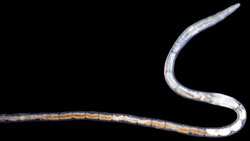New species discovered on the Great Barrier Reef

The new species of Grania discovered off the Gullmarsfjord. Photograph: Pierre De Wit<br>
The layer of sand on ocean floor is home to a large part of the vast diversity of marine species. Species representing almost all classes of marine animals live here. The genus Grania, which belongs to the class of annelid worms Clitellata, is one of them.
Grania the globetrotter
Grania is a worm around two centimetres in length and mostly white, which is encountered in marine sand throughout the world, from the tidal zone to deep down in the ocean. The researcher Pierre De Wit, at the Department of Zoology of the University of Gothenburg, is analysing exactly how many species of Grania there are and how they are related to other organisms.
Four new species
De Wit has conducted studies at the Great Barrier Reef in Australia, where he and his colleagues have found four entirely new species of the Grania worm. One of them is the beautifully green-coloured Grania colorata.
“These worms are usually colourless or white, and we have not been able to work out why this particular species is green,” says De Wit.
Separate history
De Wit has also found a previously unknown worm in Scandinavia, dubbed Grania occulta, which can only be distinguished from a previously known species by DNA. The worms' genetics show that the evolutionary history of the two species is in fact entirely separate, and that one of them is actually more closely related to a species that looks completely different.
Important knowledge
“Species that were previously regarded as the same may prove to have a completely different function in the ecosystem, and have different tolerance of environmental toxins, for example. It is obviously important to know this in order to be able to take the right action to protect our fauna,” says de Wit.
Media Contact
More Information:
http://www.gu.se/All latest news from the category: Life Sciences and Chemistry
Articles and reports from the Life Sciences and chemistry area deal with applied and basic research into modern biology, chemistry and human medicine.
Valuable information can be found on a range of life sciences fields including bacteriology, biochemistry, bionics, bioinformatics, biophysics, biotechnology, genetics, geobotany, human biology, marine biology, microbiology, molecular biology, cellular biology, zoology, bioinorganic chemistry, microchemistry and environmental chemistry.
Newest articles

First-of-its-kind study uses remote sensing to monitor plastic debris in rivers and lakes
Remote sensing creates a cost-effective solution to monitoring plastic pollution. A first-of-its-kind study from researchers at the University of Minnesota Twin Cities shows how remote sensing can help monitor and…

Laser-based artificial neuron mimics nerve cell functions at lightning speed
With a processing speed a billion times faster than nature, chip-based laser neuron could help advance AI tasks such as pattern recognition and sequence prediction. Researchers have developed a laser-based…

Optimising the processing of plastic waste
Just one look in the yellow bin reveals a colourful jumble of different types of plastic. However, the purer and more uniform plastic waste is, the easier it is to…



